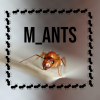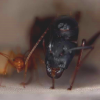I keep large (>6000) numbers of colonies, and for me, making sure ants can thrive is important. This year, I've had a lot more mold related deaths, particularly in founding queens. I've also noticed colonies where, after some time of development, the queen alone will die, while the workers remain alive and otherwise thriving. Recently, I came across this paper with a potential explanation
According to this interview Long-term consequences of early queen infection for ant colonies – Myrmecological News Blog:
"We found that an early low-level infection can often be suppressed by the queen’s immune system, yet it can turn lethal when she overinvests in brood production. An infection slows colony growth before hibernation but the colonies that survive show compensatory growth afterward. "
"We exposed queens to infective spores of a fungal pathogen (Metarrhizium brunneum) which is abundant in the soil and often attacks ants (and many other insects) in nature. The pathogen kills many within days and stays latent within the surviving queens, only to re-emerge as a threat at a later critical stage of colony development. "
This is my interpretation of how this might apply to ant-keeping.
A lot of times, ant keepers have talked about SQD "Spontaneous Queen Death", where the queen in a colony dies, seemingly for no reason, while the workers and brood remain healthy and even thrive. To me, this provides a potential explanation. An initial low-level infection before founding can hurt the queen, but remain asymptomatic for long periods of time. As the colony grows, and the queen invests more energy into reproduction instead of her immune response, the disease can "come back" and kill the queen. Another interesting thing about ants is that they have TGIP (Trans-Generational Immune Priming). Basically, queens will pass on "immune" responses to disease they faced in their lifetime to their offspring.
This would explain why workers would otherwise be thriving- they have a strong immune response to the disease, while the weakened queen, as she diverts resources away from her immune system, becomes more vulnerable. So, I thought about trying different potential solutions.
Here is my plan to cut deaths due to disease and other "unknown" causes to the greatest extent I can. All listed methods have shown some potential ability to treat. Not all parts of the plan have been implemented, but I plan to test each method within 6 months and implement what works within 12 months.
Stronger Equipment Sterilization
One concern I had is that I may be spreading disease from one colony to another if I reuse containers without fully sterilizing them between colonies. I am currently testing Odoban to soak my outworlds, setups, and test tubes in for several hours before drying and reuse. It is a pet-safe enzyme based disinfectant which claims to kill the majority of microorganisms. I will need to dry it off to make sure it does not significantly harm the gut microbiota of the ants, particularly for Blochmannia bacteria, which have symbiotic relationships with Camponotus, and Wolbachia, which do not.
Given that Odoban is a common cleaner, I will implement its use on it's own for now, but I may try to use a lab grade soap such as Alconox to remove any trace residues of the Odoban. In addition, I have implemented a detergent wash and pasteurization process to kill bacteria in the byFormica liquid feeders I use between each colony.
Experiments in Ant Medication
Pathogen Prevalence Modulates Medication Behavior in Ant Formica fusca - PMC (nih.gov)
This paper above mentions that Formica fusca will self medicate with volatile compounds like H2O2 to combat infections of Beauveria bassania. I am currently experimenting with providing two feeders to some of my colonies with byFormica Sunburst Nectar, and another feeder with a sugar-food dye-hydrogen peroxide solution. In the past, I have definitely noticed disease outbreaks in some of the larger colonies (e.g. a mold spreads throughout the colony). I do not have enough ants to produce a large sample size, but these are treatments we are starting to implement in case they might work. Further research will try to quantify the efficacy.
I also have figured out how to make alginate balls (think boba pearls) filled with sugary hydrogen peroxide as a potential "dosable" medicine for the ants. If the preliminary results in the large Formica feeders are succesful, I will explore this further.
Natural Anti-Septics in Ant Colonies
This paper mentions that various Formica spp will apply formic acid to tree resin to create a strong antiseptic which is potent against Metarhizium brunneum for up to several centimeters across. My plan is to purchase some tree resin, and see if it decreases death rates if I place it in the outworlds of 2 treatment groups. 50 Camponotus with resin, 50 without, 50 Formica with resin, and 50 without. Camponotus is another species I find in habitat with lots of pine forest, and so I assume
If successful, I will try to embed chunks of tree resin into my test tube outworlds.
Experiments to Reduce Mold Growth
https://www.jstor.org/stable/20095314?
This paper mentions the usage of clotrimazole in DMSO to treat various fungal infections in beetles. The main infection they attempt to treat, Beauveria bassania, commonly infects and kills ants. In addition, clotrimazole is a commonly used general-purpose antifungal used for yeast infections, athlete's foot, etc. In the following season, I will be creating experimental groups of Lasius neoniger. One group of 50 will be sprayed with a commercially available 1% clotrimazole solution, another group will be sprayed with commercially available 1% micronazole nitrate, a third group will be a control.
The intention of the experiment is to verify whether topical spray of any of the above treatments are able to reduce deaths and infections from fungus. I will track the number of deaths, total, as well as the number of deaths where fruiting bodies (visible mold) is present.
Tyrosine Supplementation
Many insects seem to use melanin as a way to "encapsulate" different pathogens. Generally, darker bodies seem to be more "immune" to disease in experiments with mealworms. Tyrosine seems to be an amino acid which, when supplemented to mealworms, are able to significantly improve melanin production. I am still unsure how I plan to do this, but at some point (likely late 2025) I will look into Tyrosine supplementation into ants, perhaps via a gutload with feeder insects or with a liquid broth imbued into chicken, shrimp, and other "human-edible" protein sources that the ants are fed.
Ant Vaccinations?
This is a "for-later" step, but there is evidence that exposing certain insects to heat treated bacteria improves their immune responses to actual infections. I am unsure how much this is required, given that increased immune responses seem to slow down colony growth speed, and I am yet unable to identify any common bacterial infections which are killing ants. If this tends to happen, I will look more into it.
Some of these may become products, others probably not, but you will be able to see some of the R & D process through this thread if I remember to update it.
Edited by Canadian anter, September 1 2024 - 2:06 PM.


















